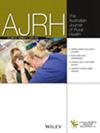Examining Differences Among Opioid Agonist Treatment Clients in Regional and Metropolitan Settings of New South Wales, Australia
Abstract
Objective
Whilst prior studies have examined characteristics and barriers for opioid agonist treatment (OAT) clients in regional settings, there are limited studies examining these differences in relation to metropolitan OAT clients. This study aimed to examine key characteristics, including sedating medication and substance use, transport and driving behaviours and differences between OAT clients within regional and metropolitan areas of New South Wales, Australia.
Design
Cross-sectional survey of OAT clients.
Setting
Fifteen public OAT clinics across New South Wales, Australia, between January 2020 and June 2021.
Participants
Survey was completed by 482 people currently receiving OAT.
Main Outcome Measures
Self-reported sample characteristics, self-reported sedating medication use and substance use, transportation and driving histories.
Results
Significant differences in OAT pharmacotherapies prescribed between regional and metropolitan participants were noted (aOR = 2.42, 95% CI = 1.42–4.11). Methadone was the most commonly prescribed OAT in both settings (74.1% and 54.4%, respectively). Nearly half (45.6%) of regional participants received OAT from a private dispensary compared to 4.7% in metropolitan areas. While few differences in past-month substance use were noted, reported heroin use was lower (aOR = 0.27; 95% CI = 0.09–0.78) in regional areas. Regional participants were more likely than metropolitan participants to drive a vehicle to dosing (aOR = 2.89, 95% CI = 1.12–7.46) and less likely to take public transport (aOR = 0.41, 95% CI = 0.18–0.93) or active transport (aOR = 3.75, 95% CI = 1.50–9.40). Few differences regarding driving offences, based on geography, were noted.
Conclusions
Key differences with treatment, substance use, transport and driving were noted within this study. It is evident that regional OAT clients more often rely on motor vehicles to complete daily activities. Such challenges related to OAT should be addressed by informed policy and regulatory changes that ensure access and equity of treatment and safety, regardless of location.

 求助内容:
求助内容: 应助结果提醒方式:
应助结果提醒方式:


